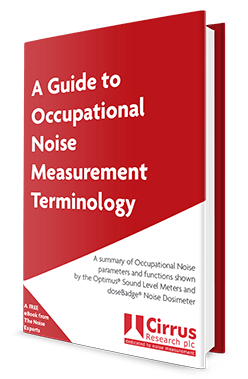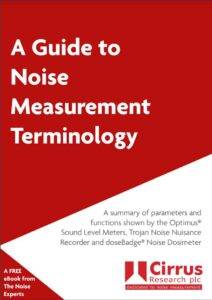A Guide to Occupational Noise Measurement Terminology [Free eBook]
The most advanced sound level meters can measure more than 100 different noise parameters at the same time. Each parameter can tell you something different the occupational noise you’re measuring. How do you remember what all this noise terminology means and what it does?
In our new eBook, A Guide to Occupational Noise Measurement Terminology, we reveal the most common noise terminology used for measuring noise at work. We’ve included a brief explanation of each parameter and noise term to help you with your noise measurements.
What the Occupational Noise Terminology Guide includes:
- Key noise terms that every Health & Safety Manager needs to know
- Descriptions of all the noise terminology and parameters for occupational noise monitoring
- Explanations of the more general noise measurement terms used
- Reference guide for the Standards for Sound Level Meters, Noise Dosemeters and Acoustic Calibrators
- For Cirrus customers, a look at what the different View Screens on the Optimus® Sound Level Meter can show you
Example: Key Noise Term
‘A’ Weighting – ‘A’ Weighting is a standard weighting of the audible frequencies designed to reflect the response of the human ear to noise.
The ‘A’ Frequency Weighting network is the most widely used, and is used to represent the response of the human ear to loudness. Measurements made with this frequency weighting will typically be displayed as dB(A) or dBA. For example, as LAeq, LAFmax, LAE etc where the A shows the use of ‘A’ Weighting.
Example: Noise Terminology and Parameters
LAFmax – The maximum Sound Level with ‘A’ Frequency weighting and Fast Time weighting during the measurement period.
Example: General Noise Measurement Term
Dynamic Range – All noise instruments are limited in the range of levels that they can accurately measure by inherent noise at low levels and by overload at high levels.
The usable region between these two is the dynamic range of the instrument. Expressed in dB.
Check out the Occupational Noise Terminology Guide to expand your noise knowledge and the types of workplace noise measurements you can make.
Jaymee-lee Tolliday
Latest posts by Jaymee-lee Tolliday (see all)
- Turning Down the Volume: How the Trojan Noise Nuisance Recorder can help create a quieter world - 13th February 2024
- Festive Opening Hours 2023 - 6th December 2023
- Award of Excellence for Cloud-Based Monitoring Solutions 2023! - 20th November 2023

